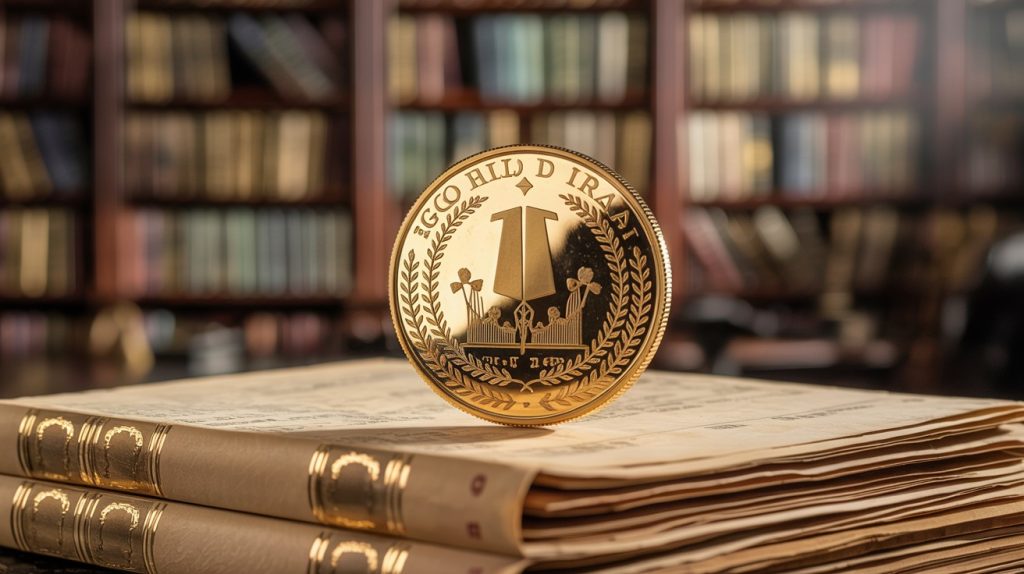On This Page
Table of Contents
Investing in gold has been a time-tested strategy for wealth preservation. In the modern investment landscape, many investors are turning to Gold IRAs (Individual Retirement Accounts) as a way to diversify their portfolios and protect their savings from inflation and market volatility. If you’re looking to learn more about Gold IRAs, this guide will provide you with an in-depth overview, from the basics of a Gold IRA kit to understanding the Gold IRA vs Roth IRA debate. We’ll also touch on important topics like Gold IRA fees, the pros and cons of Gold IRA investing, and how to avoid Gold IRA scams.
What is a Gold IRA?

A Gold IRA is a self-directed individual retirement account that allows you to hold physical gold as part of your retirement savings. It’s a specialized form of a traditional or Roth IRA that focuses on gold, typically in the form of bullion, coins, or bars. It offers an excellent way to hedge against economic uncertainty and inflation.. Investors may also explore Digital Gold Currency as a modern alternative for storing gold in digital form.
Gold IRA Kit: A Gold IRA kit typically includes the necessary paperwork and instructions to help you start investing in gold for retirement. Some companies offer a free Gold IRA kit, which can be useful for those who are new to this type of investment.
Types of Gold IRAs: Self-Directed vs. Custodial
- Self-Directed Gold IRA: This type of IRA gives investors full control over their investment choices. It allows you to choose specific gold assets to include in your portfolio, such as IRA-eligible gold like coins and bars from approved mints.
- Custodial Gold IRA: A custodial IRA requires you to work with a custodian or a financial institution that will manage your investments on your behalf.
Gold IRA vs Physical Gold: What’s the Difference?
When comparing Gold IRA vs Physical Gold, the main distinction lies in how the gold is held and managed. This is also where many investors explore broader concepts, such as Types of Gold Mining, to understand how gold reaches the market before becoming an investment asset.
- Gold IRA: The gold is held in a retirement account by a custodian, and it is subject to the rules and regulations of IRAs, including taxes and withdrawal restrictions.
- Physical Gold: When you invest in physical gold, you own the gold outright and can store it as you see fit. Investors should also consider Physical Gold vs Gold Funds to decide between direct ownership or pooled investment products.
Understanding Gold IRA Fees and Costs
Like any investment, Gold IRAs come with costs. These can include:
- Setup Fees: Some custodians charge a one-time setup fee for opening a Gold IRA.
- Storage Fees: If you hold physical gold in your Gold IRA, the gold will need to be stored in a secure, IRS-approved depository.
- Management Fees: Depending on the custodian, you might incur annual management fees.
It’s essential to research the Gold IRA fees associated with each plan before committing.
How Does a Gold IRA Work?
A Gold IRA works similarly to a traditional IRA. You make contributions (up to IRS limits), and your investment grows tax-deferred until you retire. You can choose to invest in gold-related assets like Gold ETFs or physical gold held in storage. Gold ownership may also research What Is BitGold, which provides a platform for buying, selling, and storing gold digitally.
How to sell Gold ETFs in a Roth IRA: To sell a Gold ETF in a Roth IRA, simply instruct your custodian to sell the asset and transfer the proceeds back into the IRA.
Gold IRA vs Roth IRA
Gold IRA vs Roth IRA comes down to tax treatment:
- Gold IRA: Generally, Gold IRAs are tax-deferred, meaning you don’t pay taxes on the gold’s growth until you take distributions.
- Roth IRA: A Roth IRA offers tax-free growth, meaning you pay taxes upfront, but your gold grows without future tax liability.
How to Choose the Best Gold IRA Companies in 2025
Choosing the best Gold IRA companies 2025 involves evaluating factors such as:
- Reputation: Look for well-established companies with excellent customer reviews.
- Fees: Compare the Gold IRA fees and investment requirements of different custodians.
- Educational Resources: Top-rated companies often offer guides, such as a Gold IRA guide, to help investors understand their options.
- Customer Support: Ensure that the company provides strong support for clients looking to invest in Gold IRAs.
Gold IRA Minimum Investment Requirements

The Gold IRA minimum investment varies by company but typically ranges from $5,000 to $50,000. Some companies offer lower entry points if you start with a self-directed gold IRA or are investing in a Gold ETF instead of physical gold.
Gold IRA Pros and Cons
Gold IRA Pros:
- Diversification: Adds a stable asset to your portfolio.
- Inflation Hedge: Gold is known for preserving value during inflation.
- Tax Advantages: Enjoy tax-deferred growth on your investment.
Gold IRA Cons:
- Fees: Higher setup and maintenance fees compared to traditional IRAs.
- No Immediate Access: You cannot easily access physical gold without penalties.
Gold IRA Rollovers
A Gold IRA rollover occurs when you transfer funds from an existing retirement account, such as a 401(k) or a traditional IRA, into a Gold IRA. This is a tax-deferred process, which allows you to diversify into gold without incurring penalties or taxes.
Gold IRA Tax Rules
When it comes to Gold IRA tax rules, the same regulations apply as with traditional IRAs. You won’t owe taxes on your gold investment until you start taking distributions. However, if you withdraw funds early, you may face penalties.
FAQ’s
What is a Gold IRA Kit?
A Gold IRA kit is a set of documents and instructions provided by a custodian to help you open a Gold IRA. It typically includes paperwork, guidelines for selecting IRA-eligible gold, and details about fees and investments.
Gold IRA vs Physical Gold – Which Is Better?
A Gold IRA offers tax benefits and retirement savings, while physical gold gives you direct ownership of the metal. Choose based on whether you need the retirement benefits or prefer owning the gold outright.
How Does a Gold-Backed IRA Work?
A Gold-backed IRA holds physical gold or gold-related assets in a tax-deferred account, offering investors a way to preserve wealth for retirement.
What Does IRA Eligible Gold Mean?
IRA-eligible gold refers to gold that meets specific purity standards set by the IRS for inclusion in a Gold IRA. This typically includes gold bars and coins from approved mints.
What Is a Gold IRA Rollover?
A Gold IRA rollover involves transferring funds from another retirement account, such as a 401(k) or traditional IRA, into a Gold IRA to diversify your investment portfolio.
Conclusion
Gold IRA investing is a powerful tool for protecting your retirement savings against inflation and economic instability. Whether you’re considering a self-directed Gold IRA or opting for a Gold ETF in a taxable account, it’s essential to research your options thoroughly. With the right strategy and the best Gold IRA companies 2025, you can secure a diversified, stable retirement portfolio.
Read more about : Gold Trading Guide Strategies, Platforms & Market Insights



